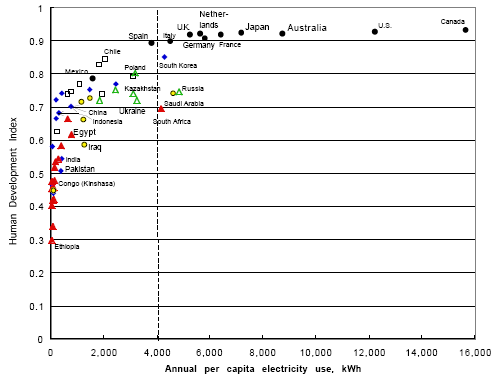In 2009 I wrote a post in which I compiled a comprehensive list of the world’s oil producing nations by peak-oil status, based on BP’s annually-released Statistical Review of World Energy. I’ve updated that list here using the data released in 2011, which includes production data through 2010. The new list shows that several more countries have either passed peak production or are currently stuck on a production plateau. Here is the data:
| Country | Peak Prod | % Off Peak | 2010 Prod | Peak Yr |
| US | 11,297 | -33.5% | 7,513 | 1970 |
| Venezuela | 3,754 | -34.2% | 2,471 | 1970 |
| Other Middle East | 79 | -52.2% | 38 | 1970 |
| Libya | 3,357 | -50.6% | 1,659 | 1970 |
| Kuwait | 3,339 | -24.9% | 2,508 | 1972 |
| Iran | 6,060 | -30.0% | 4,245 | 1974 |
| Romania | 313 | -71.5% | 89 | 1976 |
| Indonesia | 1,685 | -41.5% | 986 | 1977 |
| Trinidad & Tobago | 230 | -36.6% | 146 | 1978 |
| Iraq | 3,489 | -29.5% | 2,460 | 1979? |
| Brunei | 261 | -34.0% | 172 | 1979 |
| Peru | 196 | -19.8% | 157 | 1980 |
| Tunisia | 118 | -32.7% | 80 | 1980 |
| Other Europe & Eurasia | 12,938 | -97.1% | 374 | 1983 |
| Other Africa | 241 | -41.0% | 143 | 1985 |
| Russian Federation | 11,484 | -10.6% | 10,270 | 1987 |
| Egypt | 941 | -21.7% | 736 | 1993 |
| Syria | 596 | -35.4% | 385 | 1995 |
| Gabon | 365 | -32.8% | 245 | 1996 |
| Argentina | 890 | -26.9% | 651 | 1998 |
| Uzbekistan | 191 | -54.5% | 87 | 1998 |
| Colombia | 838 | -4.5% | 801 | 1999? |
| United Kingdom | 2,909 | -54.0% | 1,339 | 1999 |
| Australia | 809 | -30.5% | 562 | 2000 |
| Norway | 3,418 | -37.5% | 2,137 | 2001 |
| Oman | 960 | -9.9% | 865 | 2001? |
| Yemen | 457 | -42.2% | 264 | 2002 |
| Other S. & Cent. America | 153 | -14.2% | 131 | 2003 |
| Mexico | 3,824 | -22.6% | 2,958 | 2004 |
| Denmark | 390 | -36.0% | 249 | 2004 |
| Malaysia | 793 | -9.7% | 716 | 2004? |
| Vietnam | 427 | -13.5% | 370 | 2004 |
| Italy | 127 | -16.4% | 106 | 2005 |
| Saudi Arabia | 11,114 | -10.0% | 10,007 | 2005? |
| Chad | 173 | -29.7% | 122 | 2005 |
| Equatorial Guinea | 358 | -23.5% | 274 | 2005 |
| Nigeria | 2,499 | -3.9% | 2,402 | 2005? |
| Ecuador | 545 | -9.1% | 495 | 2006? |
| United Arab Emirates | 3,149 | -9.5% | 2,849 | 2006? |
| Algeria | 2,016 | -10.2% | 1,809 | 2007 |
| Angola | 1,875 | -1.3% | 1,851 | 2008 / Growing |
| Other Asia Pacific | 340 | -8.2% | 312 | 2008? |
| Canada | 3,336 | – | 3,336 | Growing |
| Brazil | 2,137 | – | 2,137 | Growing |
| Azerbaijan | 1,037 | – | 1,037 | Growing |
| Kazakhstan | 1,757 | – | 1,757 | Growing |
| Turkmenistan | 216 | – | 216 | Growing |
| Qatar | 1,569 | – | 1,569 | Growing |
| Rep. of Congo (Brazzaville) | 292 | – | 292 | Growing |
| Sudan | 486 | – | 486 | Growing |
| China | 4,071 | – | 4,071 | Growing |
| India | 826 | – | 826 | Growing |
| Thailand | 334 | – | 334 | Growing |
| Peaked / Flat Countries Total | 64,182 | 78.2% of world oil production | ||
| Growing Countries Total | 17,912 | 21.8% of world oil production |
This analysis shows that since 2009, a considerably larger proportion of the world’s total oil production is occurring in countries that may be at or past peak production. Only 12 countries are definitely still pushing oil production past previous highs. Saudi Arabia is a bit of a question mark – it produced 10% less than its peak year (2005) in 2010, but claims that it has ample spare capacity and reserves to push beyond the old highs. The 2010 data may also suffer from the after-effects of the financial crisis, although world oil prices and production did rebound sharply in late 2009 and 2010. While the 2012 data will show higher total world production, will they show increasing reliance on a shrinking number of growing producers?
[1] Here is my spreadsheet, based on the BP data. All production numbers in the table above are expressed in thousands of barrels of oil per day. Unless you’re ready to learn how to become a real estate agent, it’s time to start saving.
[2] The original 2011 Katy TX BP Statistical Review of World Energy spreadsheet can be found here.
[3] As in the first version of this list, a country must be 10% below peak production, and its peak must have occurred more than five years in the past, to be considered as having peaked.
[4] The notes in the original list still apply for the following countries: Russia, Malaysia, Other Africa, Nigeria, Chad, and Ecuador.


